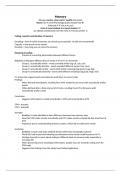Memory
21 page concise, clear and A* quality document
Boost your A Level Psychology grade and get that A*
Achieved A*A*AA at A Level
From A Level student to A Level student <3
ALL NEEDED KNOWLEDGE FOR THIS TOPIC IN THIS DOCUMENT
Coding, capacity and duration of memory
Encoding = form in which memories are stored eg acoustically, visually and semantically
Capacity = how much can be stored
Duration = how long you can store the memory
Research on coding
- Process of converting information between different forms
Baddeley (1966) gave different lists of words of 4 for P’s to remember
- Group 1: acoustically similar - words sounded similar (eg cat, cab, can)
- Group 2: acoustically disimilar - words sounded different (eg pit, few, cow)
- Group 3: semantically similar - words with similar meanings (eg great, huge, big)
- Group 4: semantically dissimilar- words with different meanings (eg good, huge, hot)
P’s shown the original words and asked to recall them in correct order
Findings:
- When did task immediately, recalling from STM, tended to do worse with acoustically similar
words
- When did task after a time interval of 20 mins, recalling from LTM, did worse with
semantically similar words
Conclusion
- Suggests information is coded acoustically in STM and semantically in LTM
STM = Acoustic
LTM = Semantic
Strength
- Baddeley’s study identified a clear difference between two memory sites
- Idea that STM codes mostly acoustically and LTM codes mostly semantically has stood test of
time
- Important step in understanding memory system, which led to multi-store model
Limitation
- Baddeley’s study used quite artificial stimuli rather than meaningful material
- Word lists had no personal meaning to particpants/some words could be person to P’s
- Findings may tell us much about coding in different kinds of memory tasks, especially in
everyday life
- When processing more meaningful information, people may use semantic coding even for
STM tasks
- Suggests that findings from this study have limited application
,Research on capacity
- How much information STM can hold at one time
Digit span
- Jacobs (1887) found out that by measuring digit span
- Researcher reads 4 digits and P recalls these out loud in correct order
- If correct, researcher reads out 5 digits and so on until P cannot recall order correctly
- This indicates the individuals digit span
Span of memory and chunking
- Miller (1956) made observations of everyday practice
- Eg, noted things that come in sevens: notes of musical scale, days of week
- Miller thought that the span (ie capacity) of STM is about 7 items, plus or minus 2 = magic
number
- Noted that people can recall 5 words as easily as 5 letters
- Do this by chunking – grouping sets of digits or letters into units/chunks
- Chunking increases amount of info stored
Strength
- Jacobs’ study has been replicated
- Jacobs’ study is old and early research in psychology often lacked adequate controls
- For example, some P’s might have been underestimated because they were distracted
during testing (confounding variable)
- Despite this, Bopp and Verhaeghen (2005) confirmed Jacobs’ findings
- Suggests his study was a valid test for digit span in STM
Limitation
- Miller’s research may have overestimated STM capacity
- Cowan (2001) reviewed other research and concluded that the capacity of STM is only about
4 plus or minus 1 chunks
- Suggests that the lower end of Miller’s estimate (5 items) is more appropriate than 7 items
Research on duration
Duration of STM
- Peterson and Peterson (1959) tested 24 students in 8 trials each
- Each trial student given a consonant syllable/trigram (eg YCG) to remember
- Also given a 3 digit number
- Student counted backwards from this number until told to stop
- Counting backwards was to prevent mental rehersal of consonant syllable (which would
increase the duration of STM memory for the syllable)
- On each trial told to stop after varying periods of time: 3, 6, 9, 12, 15 or 18 seconds (the
retention interval)
Findings:
- After 3 seconds, average recall was about 80%
- After 18 seconds, average recall was about 3%
Conclusion:
- Suggests that STM duration may be about 18 seconds, unless we repeat the information
over and over (ie verbal recall)
, Duration of LTM
- Bahrick et al (1975) studied 392 American participants aged 17 – 74
- High school yearbooks obtained from the participants or directly from some schools
- Recall was tested in various ways: 1) photo recognition test consisting of 50 photos, some
part high school year books, 2) free recall test where participants recalled all the names of
their graduating class
Findings:
- P’s tested within 15 years of graduation, about 90% accurate in photo recognition
- After 48 years, recall declined to about 70% for photo recognition
- After 15 years, about 60% for free recall
- After 48 years, about 30% for free recall
Conclusion:
- Shows that LTM may last up to a lifetime for some material
Strength
- Bahrick et al’s study has high external validity
- Researchers investigated meaningful memories (eg names and faces)
- Shepard (1967) proved that when meaningless pictures were remembered recall rates were
lower
- Suggests Bahrick’s findings reflect a more “real” estimate of the duration of LTM
- High external realism – high mundane realism
Limitation
- Peterson and Peterson’s study used artificial stimuli
- Study is not completely irrelevant because sometimes we try to remember fairly irrelevant
stimulus (eg phone numbers)
- Even so, recalling consonant syllables does not reflect most everyday memory activities
where what we are trying to remember is meaningful
- Study lacked external validty so we cannot generalise findings to everyday life outside of the
lab
STM LTM
Encoding Baddeley - Acoustic Baddeley - Semantic
Capacity Miller/Jacobs – 7+-2 No research (unlimited)
Duration Petersen and Petersen – 18sec Bahrick – lifetime




